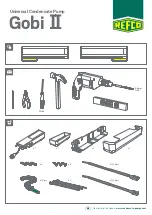
12
GB
.4. Connecting remote controller, indoor and
outdoor transmission cables (Fig.
-
)
Connect indoor unit TB5 and outdoor unit TB3. (Non-polarized 2-wire) The “S”
on indoor unit TB5 is a shielding wire connection. For specifications about the
connecting cables, refer to the outdoor unit installation manual.
Install a remote controller following the manual supplied with the remote
controller.
Connect the remote controller’s transmission cable within 10 m using a 0.75 mm
2
core cable. If the distance is more than 10 m, use a 1.25 mm
2
junction cable.
1
MA Remote controller
Connect the “1” and “2” on indoor unit TB15 to a MA remote controller. (Non-
polarized 2-wire)
DC 9 to 13 V between 1 and 2 (MA remote controller)
2
M-NET Remote controller
Connect the “M1” and “M2” on indoor unit TB5 to a M-NET remote controller.
(Nonpolarized 2-wire)
DC 24 to 30 V between M1 and M2 (M-NET remote controller)
3
Wireless remote controller(When installing wireless signal receiver)
Connect the wire of wireless signal receiver (9-pole cable) to CN90 of indoor
con-troller board.
When more than two units are run under group control using wireless remote
controller, connect TB15 each with the same number.
To change Pair No. setting, refer to installation manual attached to wireless re-
mote controller. (In the default setting of indoor unit and wireless remote control-
ler, Pair No. is 0.)
A
Terminal block for indoor transmission cable
B
Terminal block for outdoor transmission cable(M1(A), M2(B),
(S))
C
Remote controller
D
Wireless signal receiver
E
Wireless remote controller
.
. Setting addresses (Fig.
-4)
(Be sure to operate with the main power turned OFF.)
There are two types of rotary switch setting available: setting addresses 1 to 9
and over 10, and setting branch numbers.
1
How to set addresses
Example: If Address is “3”, remain SW12 (for over 10) at “0”, and match SW11
(for 1 to 9) with “3”.
2
How to set branch numbers SW14 (Series R2 only)
Match the indoor unit’s refrigerant pipe with the BC controller’s end connection
number.
Remain other than series R2 at “0”.
The rotary switches are all set to “0” when shipped from the factory. These
switches can be used to set unit addresses and branch numbers at will.
The determination of indoor unit addresses varies with the system at site. Set
them referring to the Data Book.
.
. Sensing room temperature with the built-in
sensor in a remote controller
If you want to sense room temperature with the built-in sensor in a remote
controller, set SW1-1 on the control board to “ON”. The setting of SW1-7 and SW1-
8 as necessary also makes it possible to adjust the air flow at a time when the
heating thermometer is OFF.
. Electrical work
Fig.
-4
SW14
0
SW11
SW12
1 2 3 4 5 6 7 8 9 10
ON
OFF
SW1
SWA
CN82
CN43
F
E
D
C
B
A 9 8 7
6
5
4
3
2
1
5
0
4
9
3
8
2
7
1
6
5
0
4
9
3
8
2
7
1
6
(10ths DIGIT) (1s DIGIT)
No./
No.
(BRANCH No.)
ADDRESS
3
2
1
A
A
A
C
TB5
TB15 TB5
TB15
S
M1 M2
S
M1 M2
B
TB3
M1 M2
2
1
C
2
1
A
A
C
TB5
TB5
S
M1 M2
S
M1 M2
C
B
TB3
M1 M2
1
2
Fig.
-
3
.
. Electrical characteristics
Model
Power supply
IFM
Volts
Hz
Range
- 10
MCA (A)
Output (kW)
FLA (A)
PKFY-P63VKM-E
220-240 V
50 Hz
220 V
60 Hz
Max.: 264 V
Min.: 198 V
0.36
0.056
0.29
PKFY-P100VKM-E
0.63
0.056
0.50
Symbols: MCA: Max. Circuit Amps (= 1.25×FLA) FLA: Full Load Amps
IFM: Indoor Fan Motor Output: Fan motor rated output













































